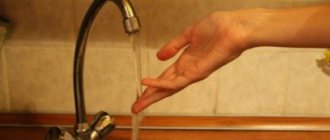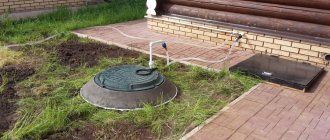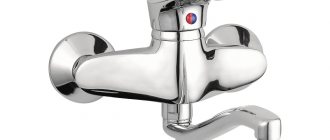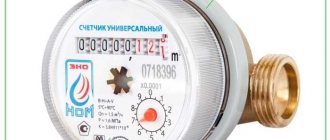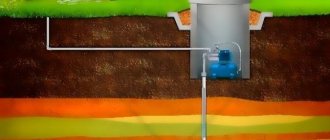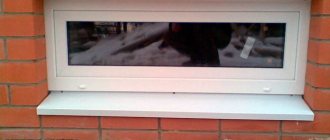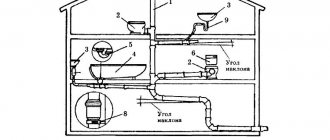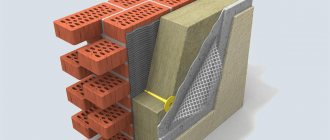Today there have been significant changes in terms of payment for water. It is produced taking into account the amount of liquid consumed. And accounting is carried out using water meters. Therefore, I would like to understand the questions of how to install a water meter, what water meters manufacturers offer today, how they differ from each other, the rules and nuances of installing the device in a water supply system.
Installation of a water meter for a private house Source besplatka.ua
Are water meters necessary?
At the beginning of the last century, the majority of water consumers from central water supply networks paid for the services of the water supply organization, taking into account established standards. These standards determined the amount of water consumed by each person living in the house. That is, the amount was fixed. Today, as mentioned above, changes have occurred.
We must immediately make a reservation that there is a government decree that clearly states that gas, water and electricity meters must be installed at each facility. But there is a caveat if their consumption is made from centralized networks. For example, for an autonomous water supply from a borehole or well, there is no need to install a meter. This also applies to the gas main if the owner of the house uses gas tanks.
Today, the installation of a water meter is planned at the stage of designing a house and utilities. If the house is old, then the water meter is installed by tapping into old water pipes.
Inserting a meter into an old water supply system Source i.ytimg.com
Installing water meters is a necessary process. The reason is an imperfect payment system based on each consumer. It is imperfect in that the water supply organization has one main goal - to make a profit. But this system does not take into account one factor - there is no control over how much water, for example, residents of a private house consumed. There are 5 people registered in the house, but three live there. Or someone went on a business trip or ended up in the hospital. Or the whole family went on vacation. All the same, payment for consumed water will be made based on five people.
Even if you don’t take into account these obvious, or rather, probable moments, and look at the statistics, then installing a water meter is much more profitable. For example, according to standards, each person must pay for 11.7 m³ of water per month. But on average, if a water meter is installed, he only pays for 4 m³. The difference is simply huge. At the same time, if you are the owner of a private house with a garden plot, then you will be charged for the territory used. After all, there will definitely be a garden or vegetable garden, a flower bed or a greenhouse, which you must water. And if you also have a car, then several cubic meters will be added to the standard.
Wash a car at home Source yandex.net
And with all this, no one takes into account whether you are watering your garden plot or whether it is completely asphalted. Do you wash your car yourself at home or take it to a car wash?
That is, it turns out that installing a water meter is much more profitable. True, you will have to make certain expenses: buy a water meter and pay for the services of installers. But, as practice shows, these expenses pay off within six months.
There is another positive side to installing a water meter. Many consumers take water for granted. Here she is and that’s it. And you can use it without restrictions. Such people do not understand that water resources are not limitless. An installed water meter disciplines such people. They don't want to pay large sums of money, so they will try to use less water. In addition, everyone tries to take care of the plumbing. A thrifty owner will not have a leaking faucet or a leaking toilet.
We do not use water sparingly Source www.trihomesol.com
In order to correctly install a water meter, and even more so, to operate it competently, you need to know its design features. The bulk of water meters are devices whose operating principle is based on the rotation of one blade element. This is either an impeller or a turbine.
The water passes through the channel where the impeller is installed. It rotates and transmits torque to the counting device. The latter can be mechanical or electronic. One revolution of the impeller corresponds to a certain volume of water passed through the device.
Meters with impellers installed have one drawback. This element is subject to the influence of so-called turbulent flows. They appear when water pressure increases. Such flows reduce the speed of rotation of the blades. Let us add that the impeller itself is an inert mechanism, that is, for optimal rotation it needs a starting speed. Therefore, at the beginning of rotation the impeller has a lower speed. Although manufacturers precisely adjust it to the required dimensions.
Structural elements of a water meter Source uamagnit.com
But it should be noted that on the scale of one small house this is not so noticeable and does not have such a strong effect on consumption losses. That is why water meters of this type are so common in private housing construction.
If the water main is more serious and has high pressure, then turbine-type meters are installed. They have no shortcomings. Therefore, their accuracy is much higher.
Let us add that there are so-called combined models on sale. This is a complex device consisting of two channels that are closed by valves. If the pressure in the water supply network is low, then the water passes through the channel where the impeller is installed. If the pressure increases, the valve closes and the channel where the turbine is installed opens.
Turbine water meter in section Source www.gvte.com.ua
There are designs that are divided by the number of channels inside:
- single-jet;
- multi-jet.
In the first, the channel is a single chamber through which the entire water flow passes. It is in such devices that turbulence occurs. Secondly, the stream is divided into several channels. And it is in such water meters that there is no turbulence.
There is another classification where devices are divided into “dry” and “wet”. In the latter, the impeller is located directly in the channel and is in contact with the passing water flow. The advantages of this model: low price and insensitivity to magnetic influences. Flaws:
- quickly fails due to corrosion of metal elements, because the impeller is always in water, and the counting device is in contact with it;
- When the quality of the water mass is low, the mechanisms become clogged with sand, silt and other troubles.
In “dry” water meters, the impeller is located in the channel, and the counting device is separated from it by a sealed chamber. That is, its mechanism does not come into contact with water. This extends the life of the entire device. The transmission of rotation is transmitted through a magnetic pair. One magnet is installed on the impeller, the other on the counting device. Magnets are rings. The only drawback of this model is the presence of magnets. They do not work well if they are exposed to a magnetic or electric field. Manufacturers solved this problem by installing magnetic protection in the form of a coupling in water meters.
Dry type water meter Source poschetchiku.ru
See also: Catalog of companies that specialize in the installation of water supply, sewerage and heating systems
Today, manufacturers offer electronic water meters. Their distinctive feature from mechanical ones is a reed switch sensor, which converts the rotational movement of the impeller into electromagnetic pulses. The latter arrive on the display panel, where the water consumption is displayed. Therefore, such water meters consist of two parts connected by a cable. The display panel can be moved outside at a distance of the length of the cable. Let us add that electronic models can display not only water consumption, but also show the cost for it according to current tariffs. That is, such devices can be programmed.
What is a counter?
An accounting device designed to measure the amount of water consumed by residents is called a meter.
There are a huge number of devices of this type on the market, making it difficult to choose. Those wishing to purchase a meter need to know that all devices are divided into several main types.
Types of water meters
Let's look at what types of water meters there are and their main features. Types of water meters can be divided into four groups:
Mechanical is the most popular type of devices on the market. The operating principle of the mechanical device is based on measuring water consumption by rotating the impeller under water pressure. Water consumption is summarized by a special calculating device. Mechanical flow meters are easy to maintain and install and have a simple design. It does not require electricity to operate. The only drawback may be small errors in accounting for water consumption, but this is not critical for home use.
Ultrasonic - not demanding on the composition of water, more reliable than a mechanical device. Among the disadvantages: sensitivity to scale, bubbles, electromagnetic waves.
Electromagnetic - has high measurement accuracy and is not afraid of water contamination. The disadvantages include: complex installation, accumulation of metal particles in the passage of the device, which are attracted by electromagnetic force. It is NOT recommended to install an electromagnetic water meter in high humidity conditions.
Resonant - the operating principle is based on the conversion of mechanical energy into electrical energy. Due to the complexity of design and operation, resonant water meters are not popular.
Design and principle of operation
The meter is a compact device in a metal case, equipped with a sensor with a display. The meter is mounted directly into the pipeline. The main part of the device is the impeller, which is responsible for pumping water. The gear drive allows the counting mechanism to record the number of revolutions of the impeller. The received data is displayed in real time on the display.
Most devices are wet type meters, that is, all parts of the mechanism are in running water. These are the most reliable models with a long service life.
However, it will not be possible to install such a meter in water pipelines with water contaminated with mechanical impurities. To work in such difficult conditions, dry-type devices in which the measuring mechanism is placed in a separate sealed compartment, and the operation of the impeller is recorded by the rotation of a magnet attached to its blades.
Modern smart models equipped with a chip are very popular among buyers. Such a device automatically reads the readings and transmits them to the control center of the water utility. The only drawback is the market price. The cost of the devices is far from budget. Main advantages: accurate recording of readings, built-in calendar and clock, high degree of protection, no wires.
Important! Of the entire group of water meters, only tachometer and electronic ones are intended for household use.
What criteria are used to select a water meter?
First of all, you need to contact the water supply organization of your territorial location. There they will show you which meters need to be installed. Because today, multi-tariff payment networks have already been introduced in many regions, and it is impossible to do without pulse devices. Many water utilities offer water meters that they have in stock, as well as installation services. Here they will explain to you the rules for installing a water meter in a private house.
Pulse water meter Source prom.st
We must immediately make a reservation that you cannot purchase the device from your own hands. Why:
- there is a high probability that the water meter you purchased is a refurbished used unit, or it is of low quality;
- Some water utilities have already encountered all kinds of counterfeits, so they may not accept the meter you purchased for operation; you will have to buy another one that meets the requirements.
What it is recommended to pay attention to when purchasing a water meter:
- Before installing the water meter, you need to select it. Please know that there are two types of water meter: for cold and hot water. The first can operate in the temperature range of 5-40C, the second at 40-90C. the latter can be used in a cold water supply system, the former cannot be installed on a hot water supply. It is impossible to confuse both models, because manufacturers paint them in different colors: blue for cold, red for hot. Today, universal devices painted gray have appeared on the market. They can be used on both systems.
- The second selection criterion is the nominal diameter, designated as “Dn”. This is the diameter of the meter pipes, and it must match the diameter of the water pipe into which it fits.
Universal gray meter Source dm-st.ru
- The following is the accuracy class of the product. There are two classes: “A” - it has an accuracy of ±1%, “B” - an accuracy of ±2%. Both models can be installed in private homes. It’s just that “B” class devices are mounted only on horizontal sections of water pipes. In this case, the scale should be directed upward. A class “A” device can be installed in any area, regardless of its location or direction. The only thing that needs to be added is that class “A” meters installed on horizontal pipes cannot be placed with the scale down.
- Installation of metering devices of this type requires a preliminary determination of the water pressure inside the water supply system. Because standards have been set for them. For example, for a Du-15 meter the limit is 1 MPa, which is 10 bar. For Du-20 – 1.6 MPa.
- There are two more important characteristics. This is the maximum and nominal water flow that the device can record. For water meters Du-15: nominal is 1.5 m³/h, maximum is 3 m³/h. If the flow rate exceeds the maximum value, the device itself will quickly fail.
Attention! All important information regarding the water meter is usually printed on the front panel of the product. Or it can be found in the device passport.
Let's consider, for example, one device and the inscriptions on its panel. Here he is in the photo below.
Cold water meter Source all-pribors.ru
PURPOSE AND SCOPE
This standard specifies criteria for the selection of water meters, associated fittings, installation conditions, as well as special requirements for certain meters and the commissioning of new or refurbished meters to ensure continued accurate measurements and meter reliability.
The scope is defined in Sec. 1 GOST R 50193.1. This standard applies to the characteristics of single meters.
Special requirements for the installation of several meters when they are connected in parallel and in groups are given in the appendix.
The requirements of this standard are recommended.
Installation rules
So, let's move on to the main question - how to properly install a water meter. You need to start by contacting the water utility. There are certain laws that must be followed. As for private houses, today the meter must be installed outside the house. The reason is free access to it by representatives of the water supply organization. That is, so that they simply do not enter the house. And if the owners are absent, the inspector himself can take readings.
There are two situations related to the installation of a water meter:
- The house is just under construction.
- The house is in use and needs to be connected to an existing water supply.
Characteristics of multi-jet meters
Multi-jet differ from the type described above by dividing the water flow into several jets. The device that breaks the flow into jets is located in front of the impeller. These design features help reduce turbulence, which affects measurement error.
The advantages of multi-jet devices are ease of installation. Dismantling for the next verification of the water meter is carried out with the same ease. To do this, it is enough to separate the upper, easily removable component from the device.
They are supplied with adapter sleeves that allow the device to be installed flush with the decorative surface. They can also be equipped with pulse outputs for reading meter readings from a distance.
Video description
The video shows how to correctly assemble a water metering unit:
From this it turns out that before installing a water meter in a private house, you need to completely assemble the entire unit.
Second situation
Here the problem is solved - how to change the water meter. Previously, water meters were installed inside houses. Today, as mentioned above, they are taken outside the buildings. At the same time, they are trying to get rid of old models.
If a transfer is made, it will completely correspond to the installation. That is, the question of how to replace a water meter will not be appropriate here. Because this is, in fact, a complete installation process with the formation of a well. And although a valve or gate valve is already installed at the connection point, the remaining actions are carried out strictly according to the principle described above with the installation of a check valve, shut-off valves and a strainer.
It's another matter when the meter is in a well. It has failed and requires replacement. By law, replacing a water meter yourself must be done with notification of the water supply organization. The thing is that the device has a seal from this organization. You can't clean it yourself. This must be done by a representative of the water utility. If you show independence, then everything will turn out to have not very good consequences. You may be charged with unauthorized use of water. Like, you removed the meter and installed a straight pipe instead. And then they changed it back to the device. That is, you spent a certain amount of cubes illegally. You will be issued a fine, and if you do not pay it, you will be summoned to court, where a decision will be made based on the letter of the law.
Therefore, first of all, you need to write an application to the water utility. A representative will come and remove the filling in front of you. Now you can change. Many people are interested in whether it is possible to change the water meter themselves, or whether this should be done by representatives of the water utility. There are no restrictions here: if you want to change it yourself, if you want to use the services of specialists or third-party organizations.
You cannot remove the filling yourself Source nestudia.ru
APPLICABLE FITTINGS
When installing the meter, the following fittings are installed:
3.1. Before the counter
3.1.1. A shut-off valve or valve, preferably indicating the direction of flow. For meters with a flange connection - a valve with a full size hole.
3.1.2. As recommended in Sect. 5, a device for straightening the flow (flow straightener) or a straight section of pipe installed between the shut-off valve and the meter.
3.1.3. If necessary, a protective mesh between the shut-off valve and the meter, and for a turbine meter - up to the straight section of the pipe or flow straightener.
3.1.4. If necessary, seal the connection between the meter and the water supply pipe in order to detect unauthorized removal of the meter.
3.2. Behind the counter
3.2.1. If necessary, a connecting pipe insert with an adjustable length to facilitate installation and removal of the meter. This device is recommended for meters with qn
≥ 15 m 3 /h.
3.2.2. If necessary, a device with a drain valve that can be used for pressure control, sterilization and water sampling.
3.2.3. For meters with
q p
> 2.5 m 3 /h, a shut-off valve or valve, and for meters with a flange connection, a valve with a full-size hole acting in the same direction as the valve in front of the meter.
3.2.4. If necessary, control (control) valve.
Video description
The video shows how to correctly replace the meter and what to do with the documents:
And at the end, one more recommendation. After installation is completed, it is necessary to test the assembled unit. To do this, one tap is opened inside the house or in the yard. Then you need to open the shut-off valve in the well a little. It is not recommended to open completely immediately, because water hammer may occur in the water supply network. In this case, there is always a possibility that the meter will fail due to the impact.
As soon as the water displaces all the air from the water supply, that is, it begins to pour out of the tap, you can open the valve completely. First, the unit is checked for leaks. Secondly, they look at the pressure from the tap. Usually, if the unit is assembled correctly and there are no serious leaks, then the pressure will be optimal.
And one last thing. All metering devices are subject to inspection after a certain period of operation. This is indicated in the product passport. So, you cannot remove the water meter yourself, and therefore remove the seals. This must be done by a representative of the water supply organization. The most interesting thing is that dismantling and installation is a paid service. Yes, and checking can cost you a lot. Therefore, many owners of private houses purchase a new meter and install it instead of the old one. It turns out cheaper, and the procedure itself is simplified - you don’t have to take the device to a workshop and wait for it to be checked.
Valve type of devices
The operating principle of the valve device is similar to those listed above. It belongs to the category of dry ships. But there is a useful improvement in its design - the ability to install a water valve inside the device has been introduced, thanks to which you can immediately turn off the water. This design feature formed the basis of the name.
The valve meter is easy to install. A significant plus is that the front indicator part of the meter can be rotated 360°. In addition, you can rotate in three dimensions, which makes it easier to read the data. It can also be equipped with a pulse output.
How to take readings?
Vane and turbine meters are characterized by a visual overview of water consumption, when the user sees the cubes and their shares. A roller pointer is used to take readings.
The numbers on the VSKhN meters are clear, making it easier to collect readings. The sealed system ensures no fogging.
Using the example of a vane model, you can display the results for flow rate taking into account the following features:
- if the black numbers on the five rollers are not activated until the readings are taken, the amount of water is calculated in cubic fractions - tenths, hundredths and thousandths;
- when the user notes a change in the black numbers on the rollers, the flow rate is more than 1 cu. meters;
- The dial indicator contains information in ten-thousandth parts.
The combined meter has two displays, which provide information on the water consumed. Based on the supply source, the user sees data on temporary and permanent flow.
For electromagnetic flow meters, the data block is remote or built-in, depending on the model purchased. The display shows the current volume.
